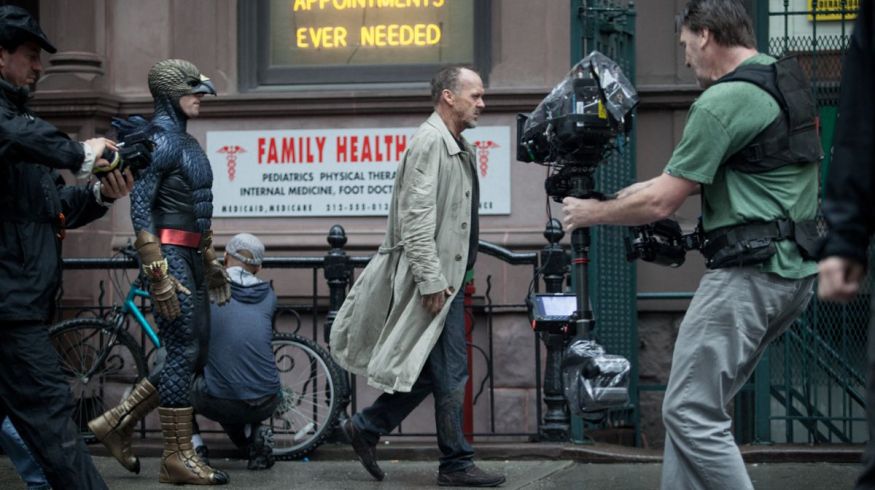
‘Birdman’ and the Art of the Long Take
We take a look at the work of cinematographer Emmanuel Lubezki and the art of the long take for his recent project, Birdman.
It’s safe to say that Academy Award winning Cinematographer Emmanuel Lubezki is a master of the long shot. From the car sequence in Children of Men to the space debris sequence in Gravity, Emmanuel has pushed the envelope in terms of what a filmmaker can do with a long continuous shot. In 2014 he completed work as cinematographer for the award-winning, Alejandro González Iñárritu directed film, Birdman. This film could very well win him another Oscar.
Birdman: Creating a Continuous World
Birdman uses long takes to make the film seem as though it was filmed in one single long shot. This was done by filming long sequences and finding cut points that weren’t jarring. Below is a short featurette of Birdman that explores the process of creating such a world, as well as the complex planning necessary in terms of camera movement, lighting of each space, framing actors and extras, among a thousand other things.
Here is a short clip from the film that showcases the camera movement and changing POV, which moves from a third person to Michael Keaton’s character then back to a roaming third person. It’s just one example that shows how Emmanuel and director Alejandro González Iñárritu meticulously crafted each and every long take of the film.
Art of the Long Take
Back in the early days of cinema long takes were a common narrative tool. Hitchcock was one of the first to employ this technique, all the way back in 1948. Fast-forward 67 years later and Alejandro González Iñárritu, along with Emmanuel Lubezki, are trying to do the same. However they aren’t the only director and cinematographer to effectively use the long shot to tell a story. Here are a few other examples of classic long shots in the history of film….
Hitchcock’s Rope
Alfred Hitchcock’s 1948 film Rope consists of 11 shots, with 10 of these shots lasting a minimum of 9 minutes. It was arguably Hitchcock’s most experimental film. Planning was careful and plotted out to perfection so that there was nearly no editing.
Here is a clip from the opening of the film:
One Long Russian Ark
While Hitchcock wanted to develop a film that had no cuts he could never fully realize that, but got close. More recently Russian director accomplished that feat with 2002’s Russian Ark. This film was shot entirely inside St. Petersburg’s Hermitage Museum with one camera in one take…that lasted 96 mins. The first two attempts were interrupted, but the final and third take was successful. The film was nominated for the highly coveted Palme d’Or at the Cannes Film Festival.
Here are the final 3 minutes of the film:
Goodfellas and the Steady Steadicam
Martin Scorsese has utilized the long shot for many years. But out of all of his films that use the long shot, none of them seem to be as highly regarded as the Steadicam tracking shot from Goodfellas.
The Mastery of Steven Spielberg
Steven Spielberg has utilized the long shot in many of his films like Jaws and Minority Report. We’d run out of space listing all the examples, but luckily Tony Zhou has compiled them for us in the video below:
Gravity: Space Debris Sequence
With Gravity Alfonso Cuaron and Emmanuel used only 156 shots throughout the entire film with an average 45 seconds for each shot. The entire opening scene, known as the ‘Space Debris Sequence’, is probably one of the most intense openings in film history:
Children of Men Car Sequence
Alfonso and Emmanuel strike again with an intense car sequence that allows the camera to move around the interior of the the car the characters are riding in. The timing for this had to be perfect since several visual effect shots had to be completed during the long shot.
Here is the full scene from Single Shot Film Festival:
This featurette courtesy of Eduardo Angel shows how they pulled it off:
My First Long Take Experience
Years ago I worked the second camera on a video art piece. The short film was shot using 3 cameras, following three subjects who would all appear on the screen at the same time. During the editing phase the frame was broken into 3rds and in each panel a single uninterrupted shot displayed until the end of the film when all three characters come together and Camera A expands to take over the full frame.
It was an amazing experience to say the least and taught me that rehearsal is vitally important to crafting a successful long shot. It also taught me that the long take can be a wildly effective narrative tool. It allows the filmmaker to really immerse the audience into the world of the character. This is something that Emmanuel Lubezki has done exceptionally well for over a decade.





